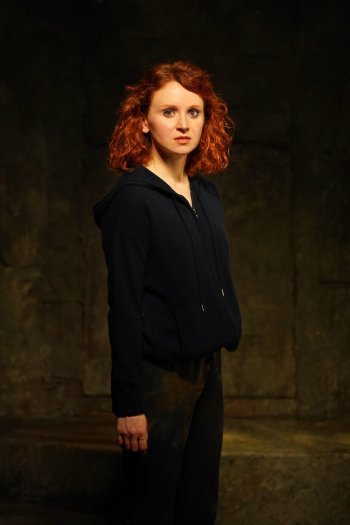A Girl Is a Half-formed Thing
In Annie Ryan's brilliant dramatic adaptation of Eimear McBride's debut novel, life is an Irish girl's nightmare.

Jenn Murray in Eimear McBride’s “A Girl Is a Half-formed Thing” as adapted by Annie Ryan at the Irish Repertory Theatre (Photo credit: Carol Rosegg)
After recently presenting theatergoers an abyss of sibling despair in Kevin Barry’s Autumn Royal, the Irish Repertory Theatre is inviting them back to stare into a much, much deeper one. This time, the source of the unfathomable darkness is Annie Ryan’s dramatic adaptation of Eimear McBride’s incessantly brutal novel A Girl is a Half-formed Thing. Told from the perspective of this eponymous and nameless girl, it’s a traumatic coming-of-age story that unfolds with a Joycean disregard for both literary conventions and those of the English language. On the page it’s a tough read; on the stage it’s an even tougher watch.
But the novel and its offshoot production are also worth the effort to endure them, despite the fact that the horrors introduced in one and distilled in the other are sadly familiar Irish subjects: parental abuse; religious abuse; sexual abuse; and, perhaps most incomprehensibly, the apparently indifferent God who allows these existential nightmares to happen. Aside from its striking stream-of-consciousness, what sets A Girl is a Half-formed Thing above and apart is its absolutely unapologetic rage, which comes from someone who almost in utero senses that the world and its Creator are betraying her. And, without any caring adult in her life to dispute this feeling, she eventually unleashes all of that rage upon herself and alone bears the punishment for being betrayed.
The girl’s only respite from anger and suffering is the love she feels for her older brother, diagnosed at birth with an inoperable brain tumor. He reciprocates his sister’s devotion, and their sibling bond offers a tenuous bulwark against complete hopelessness, until it doesn’t. And, then, there is nothing left for the girl to do except hurtle toward a final self-reckoning.
Performed as one long 80-minute monologue, A Girl is a Half-formed Thing also offers actor Jenn Murray little, if any, respite, laying on her shoulders complete responsibility for telling every detail of its emotionally unyielding story. Besides the girl, she must give voice to all of the other unnamed characters in the play, too, distinguishing them so that the staged version of McBride’s novel, where it’s impossible to simply reread a sentence, has an immediate intelligibleness. By itself, this feat is enough to make Murray’s performance astonishing, but it’s only the tip of her accomplishments.

Jenn Murray in Eimear McBride’s “A Girl Is a Half-formed Thing” as adapted by Annie Ryan at the Irish Repertory Theatre (Photo credit: Carol Rosegg)
Far more profound is the extent to which she embodies each person the girl mentions, giving them life-like dimensions and, thus, indisputably justifying the entire adaptation’s existence. Besides her incredible skill, the core of Murray’s remarkable performance (or performances) is her bravery, which the equally fearless writing requires, as she must switch from victim to victimizer, sometimes summoning the cruel motivations of the latter a heartbeat after registering the pain of the former. Although McBride and Ryan construct a solid foundation for any actor willing to take on their difficult material, the play rises to incredible heights, perhaps even greater than the novel, because of Murray and what must surely have been the sensitive guidance of director Nicola Murphy.
As evidenced by another production Murphy helmed at the Irish Rep, the thematically and stylistically similar Pumpgirl in 2019, it’s obvious Murphy knows how to nurture actors through excruciating, soul-rending moments. But, whereas Pumpgirl unfolded as a series of alternating monologues that offered its three actors the time to collect themselves in the shadows while someone else spoke, Murray is always achingly exposed, even in the dark. And Pumpgirl didn’t expect the lead actor portraying the unnamed and abused female at the center of its story to then become the despicable figure responsible for that anguish.
Wisely, when it comes to Murray’s performance, the play’s design team largely stays out of the way, adding a few foreboding touches but nothing too distracting. As if mirroring the girl’s soul, Michael O’Connor’s lighting quickly settles into a repressed and seemingly unwelcome state on Chen-Wei Liao’s crypt-like set before finally asserting itself to suggest something like an epiphany, just not one that will bring any solace. But, in retrospect, it’s early on when O’Connor’s lighting says the most, pairing ominously with Nathanael Brown’s sound design to portend the girl’s self-obliterating baptism at the end of the play, which in its aftermath leaves a devastating calm.
Ultimately, what comfort there is for the audience comes from having experienced the girl’s story collectively rather than as individual readers. Seeing your own deepest emotions on someone else’s face is one of the greatest arguments for the theater and beautifully negates any lingering doubts about returning to it. Perhaps that’s the Irish Rep’s unspoken intention from starting this season with Autumn Royal and A Girl is a Half-formed Thing: to remind us about the much-needed empathy at the heart of it all.
A Girl is a Half-formed Thing (performed live through December 12, 2021; streaming January 14 – 30, 2022)
The Irish Repertory Theatre
Scott McLucas Studio Theatre at The Irish Repertory Theatre, 132 West 22nd Street, in Manhattan
For tickets, call 212-727-2737 or visit http://www.irishrep.org
Running time: one hour and 20 minutes without an intermission






Leave a comment